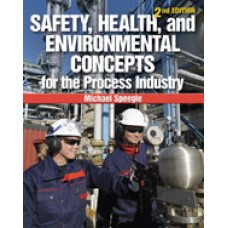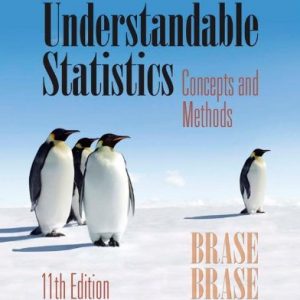This is completed downloadable of Solution Manual for Safety, Health, and Environmental Concepts for the Process Industry 2nd Edition

Product Details:
ISBN: 978-1133013471
Author: Michael Speegle
Practical and easy to understand, SAFETY, HEALTH, AND ENVIRONMENTAL CONCEPTS FOR THE PROCESS INDUSTRY, Second Edition is an essential text for anyone who apsires to work in process technology. Through a hands-on approach and direct writing style, the author succinctly covers all of the safety and regulatory issues essential to the industry. In addition, relevant topics such as OSHA regulations and analyzer technology are discussed in detail. Each chapter includes learning objectives, a list of the key terms , a chapter summary, and review questions. This thoroughly revised second edition also includes a chapter specific to OSHA and DOT, upgraded artwork, and relevant articles to enhance your understanding and demonstrate real world relevance.
Table of Content:
- Ch 1: The Process Employee’s Role in Safety, Health, and Environment
- Learning Objectives
- Introduction
- Risk in Processing Industries
- The Process Employee’s Role
- The Management of Safety
- The Process Employee and Change
- Summary
- Review Questions
- Exercises
- Ch 2: History of the Safety and Health Movement
- Learning Objectives
- Introduction
- Overview of the Safety Movement in the United States
- History of Occupational Health
- Development of Accident Prevention Programs
- The Safety and Health Movement Today
- Summary
- Review Questions
- Exercises
- Resources
- Ch 3: Accidents and Human Error
- Learning Objectives
- Introduction
- Benefits of Accident Investigations
- The Cost of Accidents at Work
- Work Injuries
- Estimating the Cost of Accidents
- Partial List of Major Industrial Accidents (1917 to 1985)
- The Human Factor
- Human Error
- Safety Promotion to Prevent Errors
- Summary
- Review Questions
- Exercises
- Resources
- Ch 4: Hazard Recognition
- Learning Objectives
- Introduction
- Physical Hazards
- Health Hazards
- Summary
- Review Questions
- Exercises
- Resources
- Ch 5: Toxic Hazards and Blood-Borne Pathogens
- Learning Objectives
- Introduction
- Toxic Substances
- Mechanisms of Toxic Agents
- Routes of Exposure
- Measurement of Toxicity
- Blood-Borne Pathogens
- Summary
- Review Questions
- Exercises
- Resources
- Ch 6: Fire and Fire Hazards
- Learning Objectives
- Introduction
- Fire Hazards
- Firefighters
- Fire Detection, Suppression, and Fighting Systems
- Types of Fire Fighting Equipment
- Summary
- Review Questions
- Exercises
- Resources
- Ch 7: Hazards of Pressure, Steam, and Electricity
- Learning Objectives
- Introduction
- Hazards of Pressure
- Other Pressure Hazards
- Hazards of Steam
- Hazards of Electricity
- Summary
- Review Questions
- Exercises
- Resources
- Ch 8: Noise and Vibration Hazards
- Learning Objectives
- Introduction
- Sound
- Hearing Loss
- Noise Hazard Standards and Regulations
- Noise Assessment
- Hearing Protection Devices
- Other Vibration Effects Besides Noise
- Summary
- Review Questions
- Exercises
- Resources
- Ch 9: Hazards of Temperature
- Learning Objectives
- Introduction
- The Body’s Response to Heat
- Thermal Burns
- Chemical Burns
- Hazards of Cold
- Summary
- Review Questions
- Exercises
- Resources
- Ch 10: Hazards of Process Sampling
- Learning Objectives
- Introduction
- Hazards of Collecting Samples
- Gas Detectors
- Summary
- Review Questions
- Exercises
- Resources
- Ch 11: Engineering Control of Hazards
- Learning Objectives
- Introduction
- Hazard Control
- Types of Engineering Controls
- Monitoring Devices
- Isolation, Lockouts, Lockins, and Interlocks
- Summary
- Review Questions
- Exercises
- Resources
- Ch 12: Administrative Control of Hazards
- Learning Objectives
- Introduction
- Administrative Programs
- Administrative Activties
- Summary
- Review Questions
- Exercises
- Resources
- Ch 13: Personal Protective Equipment (PPE)
- Learning Objectives
- Introduction
- The Personal Protective Equipment Program
- Levels of PPE Protection
- Chemically Resistant Suits
- Gloves and Hand Protection
- Head Protection
- Foot Protection (1910.136)
- Fire Retardent Clothing
- Eye Protection
- Height and Fall Protection
- Height Protection
- Fall Protection
- Summary
- Review Questions
- Exercises
- Resources
- Ch 14: Hazard Communication (HAZCOM)
- Learning Objectives
- Introduction
- Osha Hazard Communication Standard
- Employee Training
- Responsibility for Hazard Determination
- Hazard Communication Program (29CFR 1910.1200 E)
- NFPA and HMIS Warning Labels
- Material Safety Data Sheets
- Trade Secrets
- Summary
- Review Questions
- Exercises
- Resources
- Ch 15: Respiratory Protection
- Learning Objectives
- Introduction
- Respiratory Protection
- Types of Respirators
- Summary
- Review Questions
- Exercises
- Resources
- Ch 16: Process Safety Management (PSM)
- Learning Objectives
- Introduction
- The Elements of PSM
- Summary
- Review Questions
- Exercises
- Ch 17: The Permit System
- Learning Objectives
- Introduction
- Hot Work Permits (29 CFR 1910.119)
- Control of Hazardous Energy (Lockout/Tagout) 29 CFR 1910.147
- Confined Space Standard (29 CFR 1910.146)
- Confined Space Team
- Summary
- Review Questions
- Exercises
- Resources
- Ch 18: Hazardous Waste Operations (HAZWOPER)
- Learning Objectives
- Introduction
- Hazardous Waste Operations
- Emergency Response
- Components of an Emergency Response Plan
- Emergency Incident Zones
- Summary
- Review Questions
- Exercises
- Resources
- Ch 19: The Occupational Safety and Health Administration (OSHA) and U.S. Department of Transportatio
- Learning Objectives
- Introduction
- Osha is Born
- Workplace Inspections
- Citations and Penalties
- The Appeals Process
- Responsibilities Under Osha
- More about OSHA
- U.S. Department of Transportation (DOT)
- Other Agencies that Affect the Process Industry
- Summary
- Review Questions
- Exercises
- Resources
- Ch 20: Environmental Protection Agency (EPA)
- Learning Objectives
- Introduction
- Environmental Protection Agency
- Water Pollution Control
- Air Pollution Control
- Solid Waste Control
- Toxic Substances Control Act
- ISO-14000 (A Brief Discussion)
- Summary
- Review Questions
- Exercises
- Resources
- Ch 21: Stress, Drugs, and Violence
- Learning Objectives
- Introduction
- Violence in the Workplace
- Drugs in the Workplace
- Stress in the Workplace
- Summary
- Review Questions
- Exercises
- Resources
- Ch 22: Hurricanes, Plant Security
- Learning Objectives
- Introduction
- The Site Security Program
- Hurricane Protection
- Summary
- Review Questions
- Exercises
- Resources
- Glossary
- References
- Index





